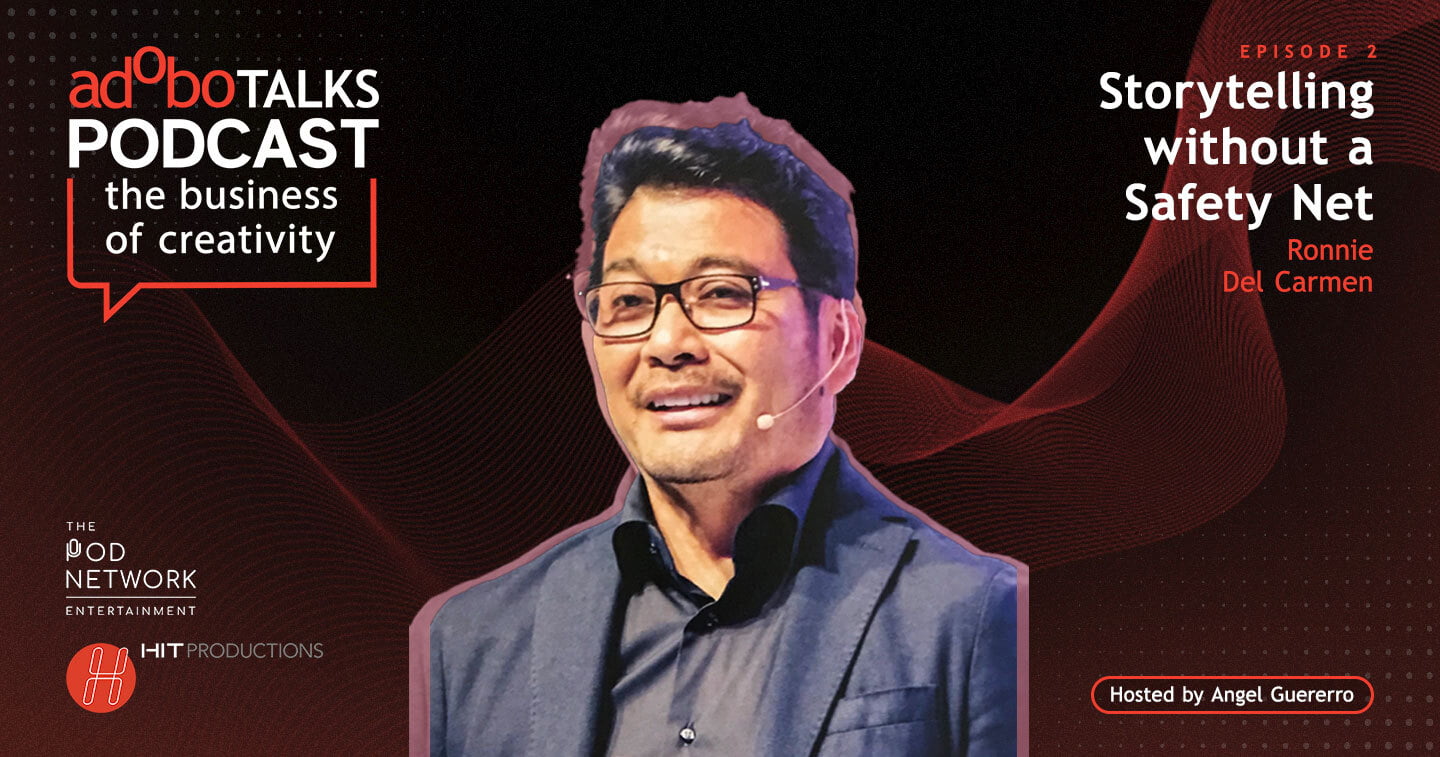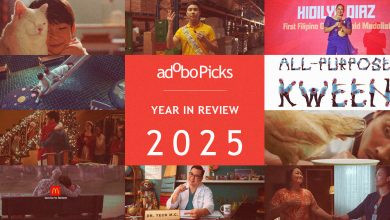MANILA, PHILIPPINES — Ronnie del Carmen never wanted to work in animation, and now he has two Academy Award nominations (one win) to show for it. In the second episode of the adoboTalks Podcast | the business of creativity, the industry veteran shared lessons from his unexpected career in making some of animation’s most resonant works.
Ronnie’s portfolio speaks for itself: his first big break came in 1992, when he became a storyboard artist for Batman: The Animated Series, often regarded as the seminal depiction of the Caped Crusader during the ’90 and early 2000s. He worked as a story artist on 1993’s Batman: The Mask of the Phantasm, then on 1998’s critically lauded The Prince of Egypt.
His knack for storytelling later earned him the role of Story Supervisor on films such as The Road to El Dorado (2000), Finding Nemo (2003), and Up (2009), for which he is also credited as one of the main creative forces behind its timeless opening sequence.
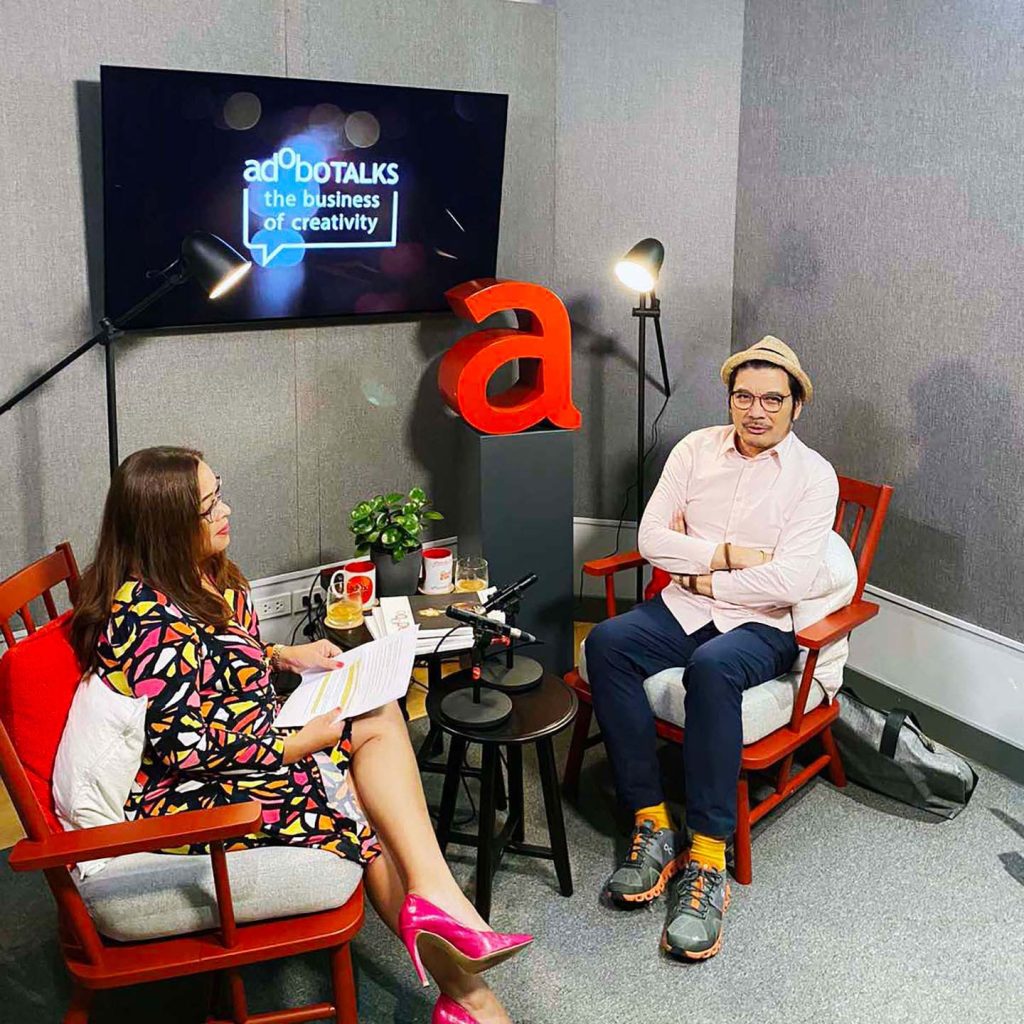
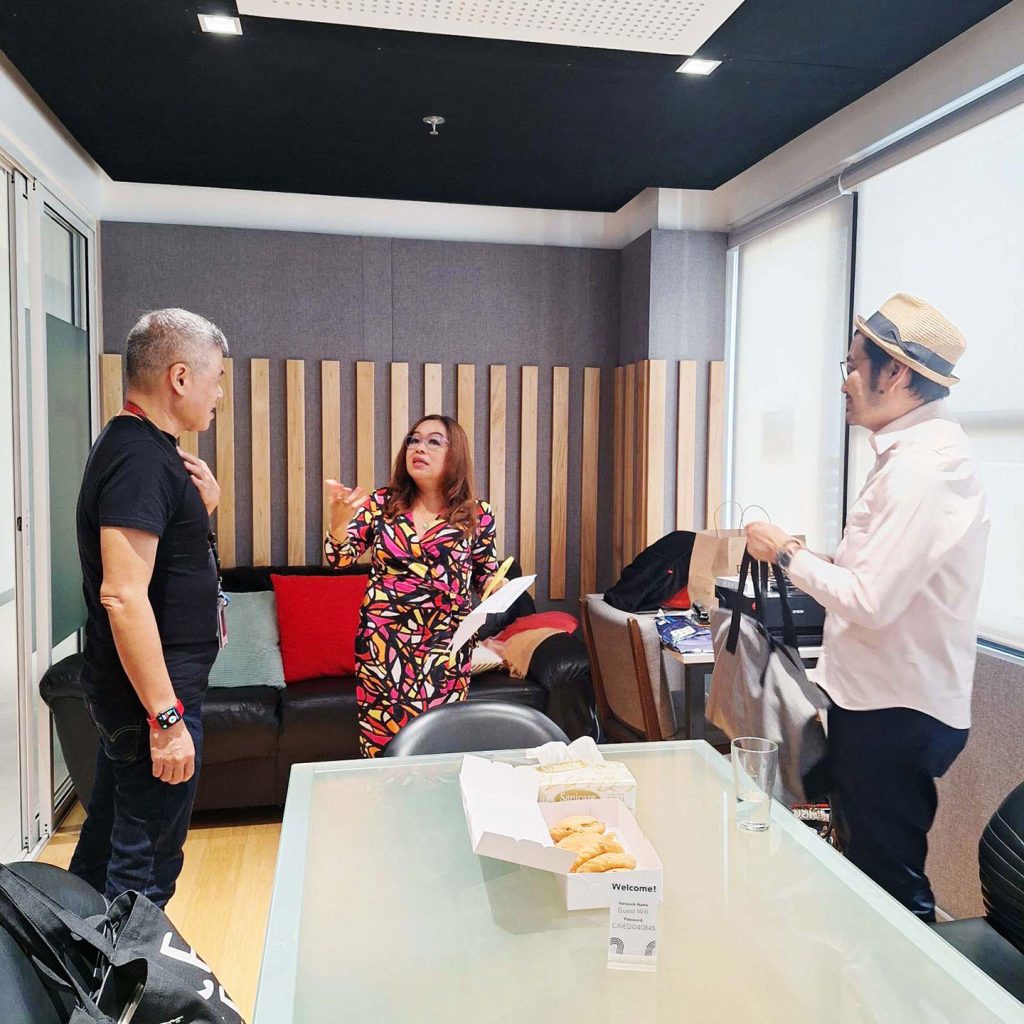
In 2015, he put out his most successful work yet as co-director and writer of Inside Out (2015), which won the Oscar for Best Animated Feature and was nominated for Best Original Screenplay. Since then, he’s served as a member of Pixar’s Senior Creative Team on Coco (2017), The Incredibles 2 (2018), and Toy Story 4 (2019), while also voicing characters in Soul (2020) and Elemental (2023).
With a resume like his, one might imagine that animation was always in the plan for Ronnie, but he’ll be the first to say otherwise. “I didn’t want it! Keep it away from me!,” he candidly told adobo Magazine President and Editor-in-Chief Angel Guerrero during his interview at the adoboTalks Podcast.
Destiny, as well as his own openness to failure, ensured that he would become a role model to Filipino storytellers everywhere. In his podcast episode, “Storytelling without a Safety Net,” Ronnie shared the following key lessons he’s learned through his reluctant 30-plus-year career in animation:
Stay open – the career you never wanted may be the one you fall in love with
In another world, Ronnie might have been one of the Philippines’ top advertising creatives. It was, after all, what he went to school for.
“I graduated in Fine Arts but majored in Advertising,” he shared. “I went to do that course specifically to do this unholy marriage of art and commerce, to be able to draw and create, but get paid and make ads for soap and toothpaste.”
“I did that here in Makati, a long time ago. I had a great time, actually!,” he added.
In 1989, however, Ronnie migrated with his family to the US, where his father had spent the last 11 years working on his residency paperwork. The job market for advertising was wildly different in Ronnie’s new home, and doors weren’t opening for him.
Then, a friend of his suggested he apply to be animator Stephan Martiniere’s assistant, a prospect that immediately revulsed Ronnie.
“It is an industry that I swore I would have nothing to do with,” he expressed. “The thing about animation is that the principle of animation is that 24 frames is what you need to have one second of experience. Twenty-four drawings for one second of experience! That’s a lot of drawings for one second of experience. So I was like, ‘I don’t want that job!’ I’m an illustrator. No, I want one drawing to tell me whole stories.”
But that was the open job, and it ended up being the start of an illustrious career.
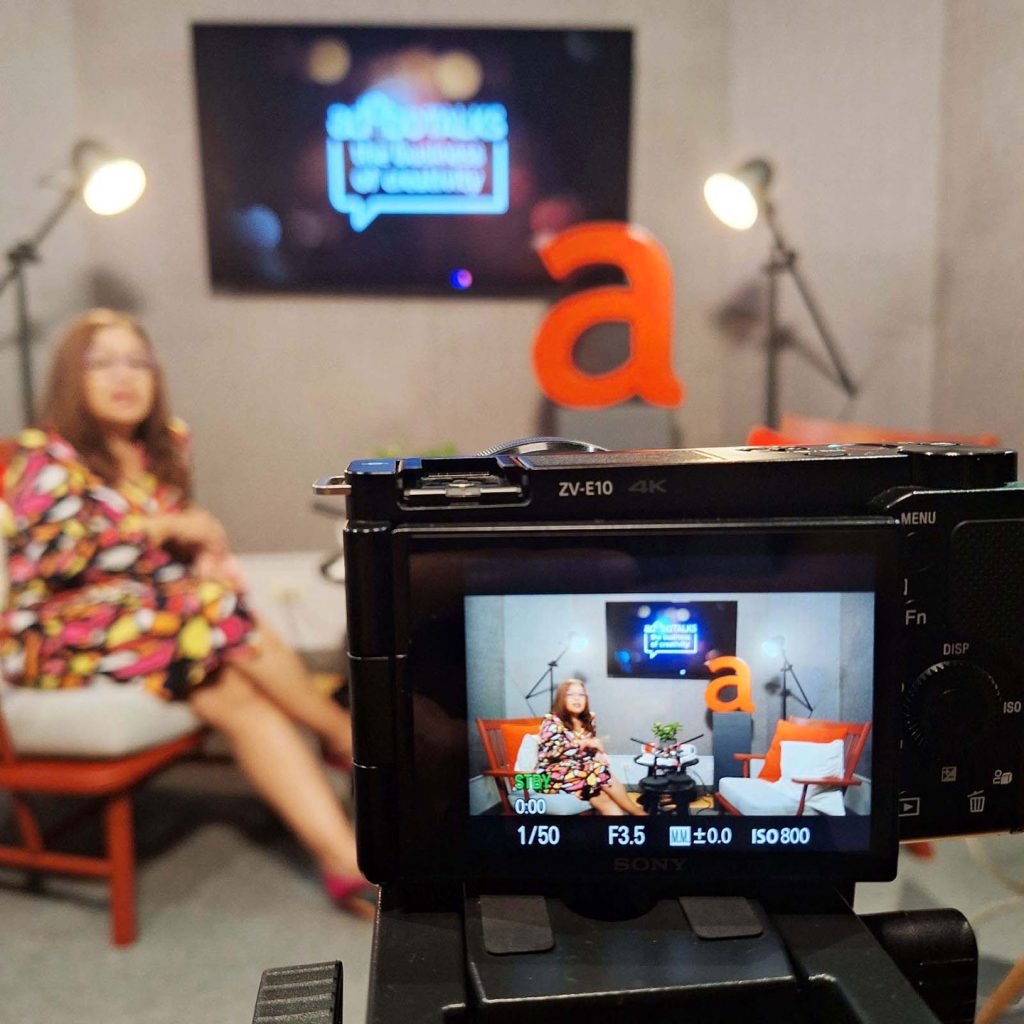

A learning mindset is what sets great storytellers apart from average ones
It would turn out that much of Ronnie’s reluctance to enter animation came from insecurities about his education. He had only taken one class in animation during college, and he wasn’t exactly a fan of his instructor.
When he applied to be Stephan’s assistant, he voiced his hesitations.
“I said, like, ‘Well, Stephan, hold your horses. I’ve gotta tell you, I know nothing about animation. In fact, I don’t even really wanna be in animation.’ And then all he’s saying is like, ‘Well, I’ll teach you.’”
Through this first job with Stephan, Ronnie grew accustomed to a work environment where learning was supported and asking questions was encouraged. “I had to go and figure out how to do the job that was left to me by asking everybody, ‘What is this? What am I supposed to do with this?’ I had to find out – desperation – to go and learn it!”
“If you’re making mistakes along the way, there’ll be a lot of people you can ask.”
A couple of years later, Ronnie would again be thrust into an unfamiliar role within the animation industry. He had initially applied to work in character design for Batman: The Animated Series, but the show’s creator and producer, Bruce Timm, noticed the narrative work in Ronnie’s portfolio and hired him as a storyboard artist instead. What followed was essentially on-the-job training on cinematic language and the craft of storyboarding.
Ronnie attributed his ability to survive all this to his readiness as a learner.
“This is the curious thing about what I feel is a mystical rule about being out there in the world, not just anywhere – I mean, in the Philippines, I felt like it may have happened – but it’s happened to me around the world: there is a system that’s in place that you can rely on, that if you are earnest and needing the help to upgrade your knowledge, there will be people who show up to help you,” he said. “The expression is when the student is ready, the teacher appears.”
“But the first part of the expression – when the student is ready – that’s when the teacher appears,” he continued. “Because if the student’s not ready, you can’t learn even if the teacher’s there. So when those moments happened to me, I’d pay attention.”
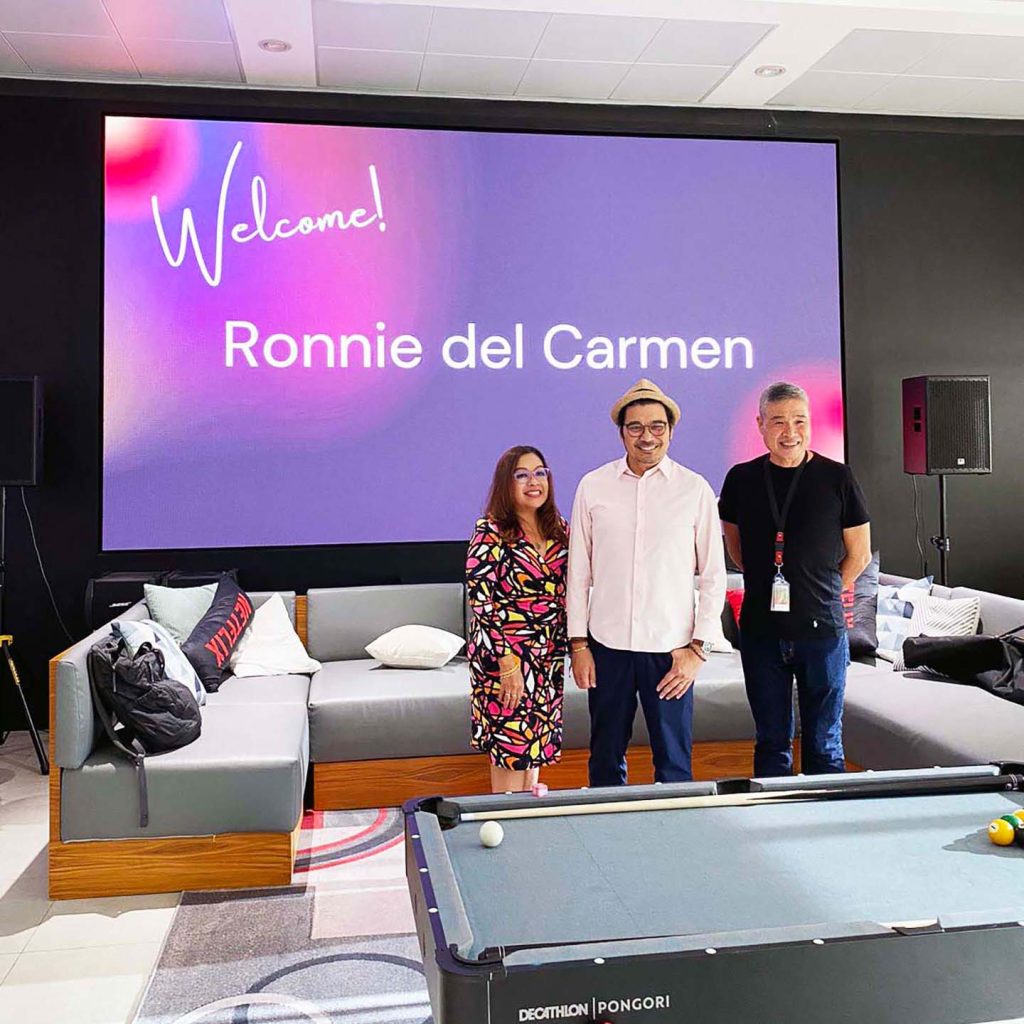

Failure is a storyteller’s best friend
Ronnie also shared his thoughts on failure as an opportunity to learn, rather than the career-ending downfall it feels like. What is important, he said, is that we create a work culture that allows us to fail over and over again until we get it right.
“Failure is failure; I don’t wanna sugarcoat it like it’s fine. It’s not. It stinks. It hurts. It’s embarrassing,” he confessed, before expounding on how his co-workers helped him re-frame his relationship with failure. “I started to learn that my friends also weren’t broken about it. It wasn’t disabling. And they didn’t carry it past that moment when it stung. And they redoubled their effort.”
“[For] most people who I work with, who have to give you just the plain unvarnished truth that it’s not working, it’s not personal – it’s about the work. It’s not succeeding. Not you. Because you are gonna come back. You’re gonna come back with another solution that may also not work. Maybe ten more times. Maybe 20.”
That much rang true during story development for Inside Out, for which he won his Oscar. The team was, in his own words, clueless about what to do or how to make the story work for roughly three whole years. Because of their persistence and strong creative leadership, they finally started to make everything make sense.
“At some point, all of the dues paying, the failures – at some point, on the planet, there were only a choice few people who deserved to tell this story,” he said. “And we were it. But it was not going to become a daily success story. We failed more times than we’d care to admit. And in the culture we’re in, all of the people around us are going to say, ‘Yeah that didn’t work – but you’re gonna get it.’”
“Now, who’s the leader do you wanna listen to? The one who just wants to finish the movie, make a good movie?,” he continued. “Or the one who says, ‘I want you to go for it.’ And they’re not gonna be able to give you more time or more resources; they just wanna believe in you, that you can make a great movie. That’s a lot of fuel.”
Safety hinders innovation
The fear of failure, Ronnie explained, is also what leads many storytellers to play it safe with their material. But playing it safe is exactly what leads to a dearth of innovation, especially in creative industries like film-making.
“You put in things that are familiar, and then people are not happy,” he said. “They’re like, ‘I’ve seen this before; it’s been done better elsewhere.’ Why? Because I borrowed it from other things!”
However, this need for safety – this aversion to risk – is something Ronnie believes to be a product of traditional educational systems. Most schools reward students for delivering the expected; put the right answer on the blank, and you get a medal. The moment you go off-book, however, you’re wrong.
It’s this mindset that Ronnie hopes every storyteller gets to shake off. It took him years in the animation industry to learn how to veer away from making what he thinks to be the right choices, and instead explore other ways of making an impact on his audience.
“Movie-making is not about coming up with the expected; otherwise we shouldn’t watch these movies because we know what to expect,” he said. “We want surprise, we want thrills, we want emotions that we didn’t think we were gonna feel.”
“The thing about it is that I’m late to the party,” he continued. “That was the job. I was trying to say it’s this other job. But they were always telling me […] you’re supposed to do this. It’s actually working without a net.”
“You could fail. It could be embarrassing. But do it. There is no roadmap; you’re gonna risk it.”
YOU are the story
Ronnie’s last piece of advice for storytellers was that, once you’ve grown accustomed to treating failure as a learning opportunity, and that taking risks is what leads to brand-new stories, the best place to mine for emotionally resonant moments is your own life.
One of his earliest challenges was during his time working on The Prince of Egypt. His pitches had repeatedly been shot down, and no matter what he did, he just couldn’t write a scene that excited his supervisors. As he put it, heading into the pitch was “like walking into a punch.”
Then a lightbulb flashed over his head.
“You know what I did? I was like, ‘You know what, my brothers and I used to actually hang out together, and this is a movie about brothers,” Ronnie said.
“When we were young, my mom would ask us to take naps in the afternoon. To me, it felt like, ‘I’m a boy, and I wanna go and play!’ So I would wake my brother; ‘Come on, let’s go!,’ and we’d sneak out the house, climb the guava tree behind the house, and we would play like little monkeys,” he shared. “It was so fun; you’re swaying from the branches, you’re having a good time and laughing. And then my mom would wonder like, ‘Where are the boys?’” And then she would open the door to the house and scream to the neighborhood.”
“And then what we’d do is we’d climb down the tree and go in the back and come in, and it’s just like, ‘What’s the matter? What are you looking at?’” he chuckled. “We’d trick her and we’d feel like, ‘Oh that was awesome! We should keep doing that!’”
“I put it in the story of Moses and Ramses,” he said. “When Ramses is there inside, a failing king, and then Moses comes in and then starts talking to statues, and telling the statues that ‘I remember when we used to switch the heads of these gods over here, and dad got angry.’ And then the statue answers back, ‘Yeah that was a lot of fun, except I’m the one who got in trouble!’”
It was this very scene that excited the team during Ronnie’s next pitch. Because he had drawn from his own experiences with his brother, the film’s two leads also started feeling like brothers themselves. Tapping into his personal history made their relationship feel that much more real and that much more resonant.
Since then, Ronnie has been unafraid to let his own story be part of the films he makes. This was most apparent in Up, wherein the lead character Carl was, by accident or suggestion of the subconscious, the spitting image of Ronnie’s own father. In working with a character that felt so familiar to him, Ronnie was able to help create the intimate, yet emotionally powerful opening to the movie.
Catch the inspiring full conversation with two-time Oscar-nominated Filipino animator and storyteller Ronnie del Carmen on Episode 2 of the adoboTalk Podcast on Spotify, YouTube, and Soundcloud.
The adoboTalks Podcast, adoboTalks | the business of creativity, is presented by adobo Magazine, and produced in partnership with The Pod Network and Hit Productions. The adoboTalks Podcast is available on Spotify, Soundcloud, and YouTube, with a new episode premiering every Thursday at 7:00 am.

